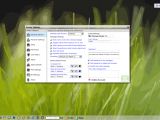WebOSs came into form ages ago, in Internet years. A year ago or so was the first time I really took the time to see what all the noise about this was. Not that I was ignorant of the subject, but I simply did not think that the matter was worth the time for a deeper investigation. I had a vague idea on how they work and a better one on the promises and future expectations.
With all the abundance of online services (web mail, remote desktop, file sharing, online data storage, instant messaging, media file conversion) it was just a matter of time for entire applications to be ported online and rid you of the trouble of installing them on your desktop and face all sorts of incompatibilities and hassles.
Well, Webtops commenced to get more and more attention and they are getting better and better (a logical turn of events). But are they the right path to follow? I mean it would be great if I didn't have to defragment my computer every week (or sooner), use a myriad of registry cleaners just to keep it up and running as long as possible or protect all my files with a power belt of anti malware products that promise the moon in the sky and in fact they protect you from a limited number of nasties.
A friend of mine said that there would come a time when computer users wouldn't have to worry about all these anymore. The reason would be that online operating systems take over the market and for doing our bidding all we would need would consist in an Internet connected monitor with a keyboard and a mouse. Everything else (the OS with all the files and programs) would be stored on a webserver somewhere.
I have to admit that the idea of not having to deal with computer maintenance is quite appealing. But judging by the way the Webtops/WebOSs work nowadays for that to be completely viable it is still a long way to beat. The first step would be to boost the Internet connection to higher speeds than those offered by broadband. Next would be to ensure that the connection is stable and there is little risk for the user's pipe to dry up.
Once the Internet connection issue is solved, how long do you think it would take for a hacker to breach security and get control over online computers? They're not having too tough of a time with firewall-protected desktops, not to mention Wi-Fi connected devices. How difficult it would be to get the details of your account (up to now Webtop access is based on a mere username and password)?
WebOS world is not as small as you would think. There are over 10 online alternatives for an operating system and they are all almost as different as Vista is from XP. Some of them offer a rich list of applications like MP3 players, text editors, internal email client, calculator and even games while others are still striving to add a minimum of functionality. But most of them have one thing in common: they are Flash based (so that'll be the new target of hackers).
However, having the looks does not mean that they also have the flexibility the user needs in order to get addicted to this or that WebOS. There is more than a simple text editor, calculator and games to make me give up my desktop or notebook. Plus none of them is speedy enough for my needs (open three or four instances of IE and try working on your computer and you'll get the idea).
Say they all improve their speed and become fully functional through their applications, would you want to adopt the new style? What about online storage? There must be a limit to your account. Now you have 1GB or 2GB per account for free and more than this requires a fee which is not at all insignificant. Goowy WebOS (http://www.goowy.com/index.aspx) gives you 5GB for $4.99/month. I'm sure that the $60/year spent on those 5 gigs can find me an HDD of at least 100GB.
And yet WebOSs are a great step forward if you're opting for mobility. You will be able to access your online operating system from any hotspot with modern devices (which, by the way, still need an operating system of their own to function and open you that web browser). An Internet connection is the requirement for accessing and running documents, music, family pictures, email client or music player. And this without downloading and installing any specific applications or worrying about compatibility issues.
The only thing you have to worry in order to get access to all these is paying your Internet bill on time. Lack of Internet will practically leave you without a computer. Having a desktop allows you access to all the data on the hard drive and you can safely watch your favorite movie or listen to your favorite playlist.
Another disadvantage with present WebOSs is that all the necessary applications for feeling comfortable with the Webtop are not yet available from third party developers. This means that if you hate the image viewer WebOS developer makes available you'll have to wait until a new version is released. The user is not given any other options right now, but maybe things will change in time.
Take a look at the images scattered around and dare click on the links. Who knows, you may like it. We've seen Vista stoned down even before the release and now it reached more than 60 million sales and the number keeps on growing as users adopt it all around the world. WebOS may come to the same fate pretty soon if injected with rapid development.
Unlike other reviewers who made the effort of analyzing 10 or even more WebOS to bring you the best of them, I limited to testing four of them (others offered limited access). I have to tell you that the looks are impressive, but what is gained here is lost in functionality. None of them were able to provide the user the minimum functionality.
Desktoptwo (my favorite) comes with a built-in email client, MP3 player, chat, Notepad, RSS reader and even a built in image viewer. I am sure that watching videos is as much a necessity as listening to music and a file compressing solution would also come in great. But look on the bright side, you can upload any file from the local computer and downloading is supported as well.
EyeOS looks extraordinary, but also shoots some blanks in an area or two. You've got a game (chess), office tools, RSS option, calculator, file upload and download options and even a process manager. Again, the suite of tools is not complete.
Glide (also a personal favorite) is impressive as the interface is interactive and the list of options include even an image editor complete with effects, image enhancement, crop and rotate options. And with Glide Sync application you can synchronize your desktop and access them from your mobile device.
With Goowy the situation is not better either. The simple package offers an instant messenger, email client, contacts and calendar options, RSS, games and limited file storage. It works, but still it lacks many options.
Just think of the first three or four applications you are launching as soon as Windows loads. If all of them are present in a WebOS then I suggest you give it a try, although I do not guarantee that you're going to like them.
And yet I still hope to see a bit more thrust in the world of WebOSs. Maybe next year or five years from now everybody will be hooked to them, but I would still want to be the owner of my computer, tweak and upgrade the way I see fit instead of taking everything for granted.

 14 DAY TRIAL //
14 DAY TRIAL // 



